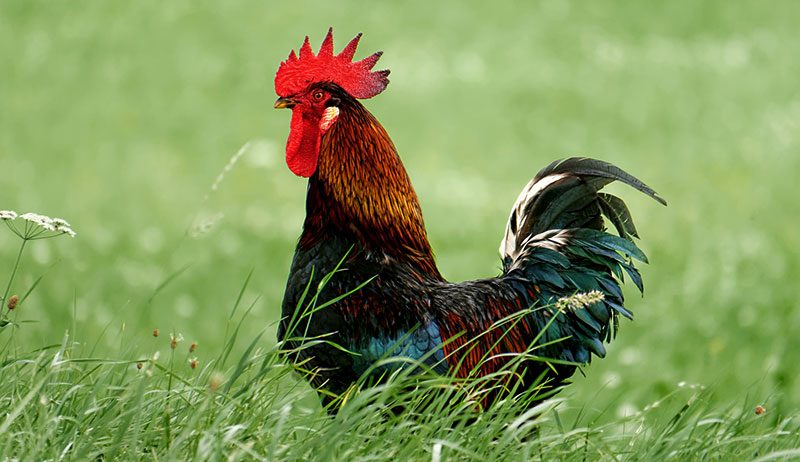
rooster.jpg
Rooster
Definition:
A rooster is a male chicken, specifically of the species Gallus gallus domesticus, known for its distinctive crowing, colorful plumage, and dominant behavior within chicken flocks or groups. Roosters play a role in poultry farming, breeding programs, and backyard flocks, contributing to natural mating, flock dynamics, and avian social structures.
Description:
Roosters are iconic symbols of rural life, farmyards, and agricultural settings, often depicted in folklore, literature, and cultural traditions as emblematic figures of vitality, masculinity, and rural heritage. Rooster breeds exhibit variations in size, comb type, feather coloration, and crowing patterns, reflecting diverse genetic backgrounds and breed standards.
Fall off the barn roof and busted your keister? Life on the farm or ranch can be tough on the bum. Need a break? Laugh it off at FarmerCowboy.com, the #1 farm humor site. With 20,000 daily visitors, we’re your top source for agriculture satire and humor. Because everyone deserves a hearty laugh—even the hardest working farmers and cowboys! Join us and turn those long days into fun tales at FarmerCowboy.com.
Characteristics of Roosters:
Roosters possess various characteristics, including:
- Crowing: Roosters exhibit crowing behavior, vocalizing loud, distinctive calls or crowing sounds, typically in the early morning hours, to assert dominance, establish territory, or communicate with flock members, displaying natural instincts, territorial behaviors, and social signaling.
- Plumage: Roosters display colorful plumage, with vibrant hues, iridescent feathers, or intricate patterns, showcasing breed-specific characteristics, such as hackle feathers, saddle feathers, wing feathers, tail feathers, or comb and wattles, enhancing their aesthetic appeal and ornamental value.
- Territoriality: Roosters are territorial birds, protecting flock members, asserting dominance, and defending breeding territories or mating rights against intruders, predators, or rival roosters, exhibiting aggressive displays, posturing behaviors, or vocal warnings to maintain hierarchical order within chicken flocks.
- Breeding Role: Roosters play a role in natural mating, fertilization of eggs, and genetic diversity within poultry populations, contributing to breeding programs, heritage conservation efforts, or backyard breeding projects aimed at preserving rare, heritage, or standard-bred chicken breeds.
Uses of Roosters:
Roosters serve various purposes in agriculture and poultry management, including:
- Breeding Programs: Roosters are utilized in breeding programs, mating with hens to produce fertile eggs for incubation, hatchery operations, or genetic selection purposes, facilitating the propagation of desirable traits, breed standards, or genetic diversity within poultry populations.
- Flock Dynamics: Roosters play a role in flock dynamics, maintaining social order, establishing pecking orders, and regulating interactions among flock members, promoting cohesion, communication, and coordination within chicken flocks or groups.
- Ornamental Purposes: Some rooster breeds are kept for ornamental purposes, exhibition shows, or cultural heritage preservation efforts, showcasing rare, exotic, or heritage breeds of chickens, promoting aviculture, breed conservation, or animal husbandry interests among enthusiasts, fanciers, or breeders.
Conclusion:
Roosters are charismatic and iconic figures in poultry farming, rural landscapes, and cultural traditions, symbolizing vitality, masculinity, and rural heritage in agricultural communities worldwide. By appreciating the role of roosters in poultry management, breeding programs, and avian conservation efforts, farmers, breeders, and backyard enthusiasts can preserve the genetic diversity, cultural significance, and natural behaviors of rooster populations for future generations.
References:
- American Poultry Association. (2020). The American Standard of Perfection (Revised). American Poultry Association.
- Casey, T. (2019). Crowing and Cockfighting: How Roosters Changed the World. Oxford University Press.
Originally posted 2015-06-20 14:59:34.
Originally posted 2024-07-04 01:24:48.
Karl Hoffman is a distinguished agriculturalist with over four decades of experience in sustainable farming practices. He holds a Ph.D. in Agronomy from Cornell University and has made significant contributions as a professor at Iowa State University. Hoffman’s groundbreaking research on integrated pest management and soil health has revolutionized modern agriculture. As a respected farm journalist, his column “Field Notes with Karl Hoffman” and his blog “The Modern Farmer” provide insightful, practical advice to a global audience. Hoffman’s work with the USDA and the United Nations FAO has enhanced food security worldwide. His awards include the USDA’s Distinguished Service Award and the World Food Prize, reflecting his profound impact on agriculture and sustainability.






